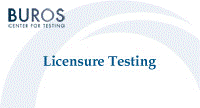Buros-Nebraska Series on Measurement and Testing

Licensure Testing: Purposes, Procedures, and Practices
Date of this Version
1995
Document Type
Article
Citation
Licensure Testing: Purposes, Procedures, and Practices, ed. James C. Impara (Lincoln, NE: Buros Institute of Mental Measurements, University of Nebraska-Lincoln, 1995).
Abstract
INTRODUCTION
A review of the literature associated with job analysis reveals two extremes of opinion as represented by the following provocative quotes:
Historically job analysis has been a relatively soporific area of industrial and organizational psychology, characterized by neither heated controversy nor prominent visibility in the research literature. (Harvey, 1991, p. 71)
Validation was once a priestly mystery, a ritual behind the scenes with the professional elite as witness and judge. Today it is a public spectacle combining the attraction of chess and mud wrestling. (Cronbach, 1988, p. 3)
Both our evaluation of practice analysis research and our professional experience with licensure programs indicate that practice analysis as a validation strategy is somewhere in between the two extremes described above.
Practice analysis:
- is a very important tool for validating licensing tests
- has become more interesting and visible than in the past
- can indeed provoke controversy (see Nelson, 1994; Schoon, 1985; Shimberg, 1990;)
DEFINITION OF PRACTICE ANALYSIS
Whether one views the process as soporific or a public spectacle, the fact remains that the systematic collection of data describing the responsibilities required of a professional and the skills and knowledge needed to perform these responsibilities is the foundation upon which to build a viable and legally defensible licensure examination.
A variety of terms have been used to refer to the collection of this type of job related data, including job analysis, role analysis, role delineation study, process analysis, and practice analysis. This chapter will use the latter term for several reasons. First, the term may be viewed as more accurately reflecting the comprehensive nature of professional practice, as opposed to the narrowly focused activities covered in a traditional job analysis (Smith & Hambleton, 1990). Second, traditional job analysis differs from licensure-related practice analysis, in that the former assesses responsibilities and know ledges necessary to successful job performance (McCormick, 1976), whereas the latter focuses on minimal though critical competencies required to protect the public (Kane, 1982b). Thus, when a practice analysis is conducted for purposes of validating licensure examinations, the professional responsibilities examined are those of an entry level, rather than advanced practitioner and these competencies mayor may not be related to professional success.
Included in
Adult and Continuing Education and Teaching Commons, Educational Assessment, Evaluation, and Research Commons, Other Education Commons


Comments
Copyright © 1995 by Buros Institute of Mental Measurements. Digital Edition copyright © 2012 Buros Center for Testing.